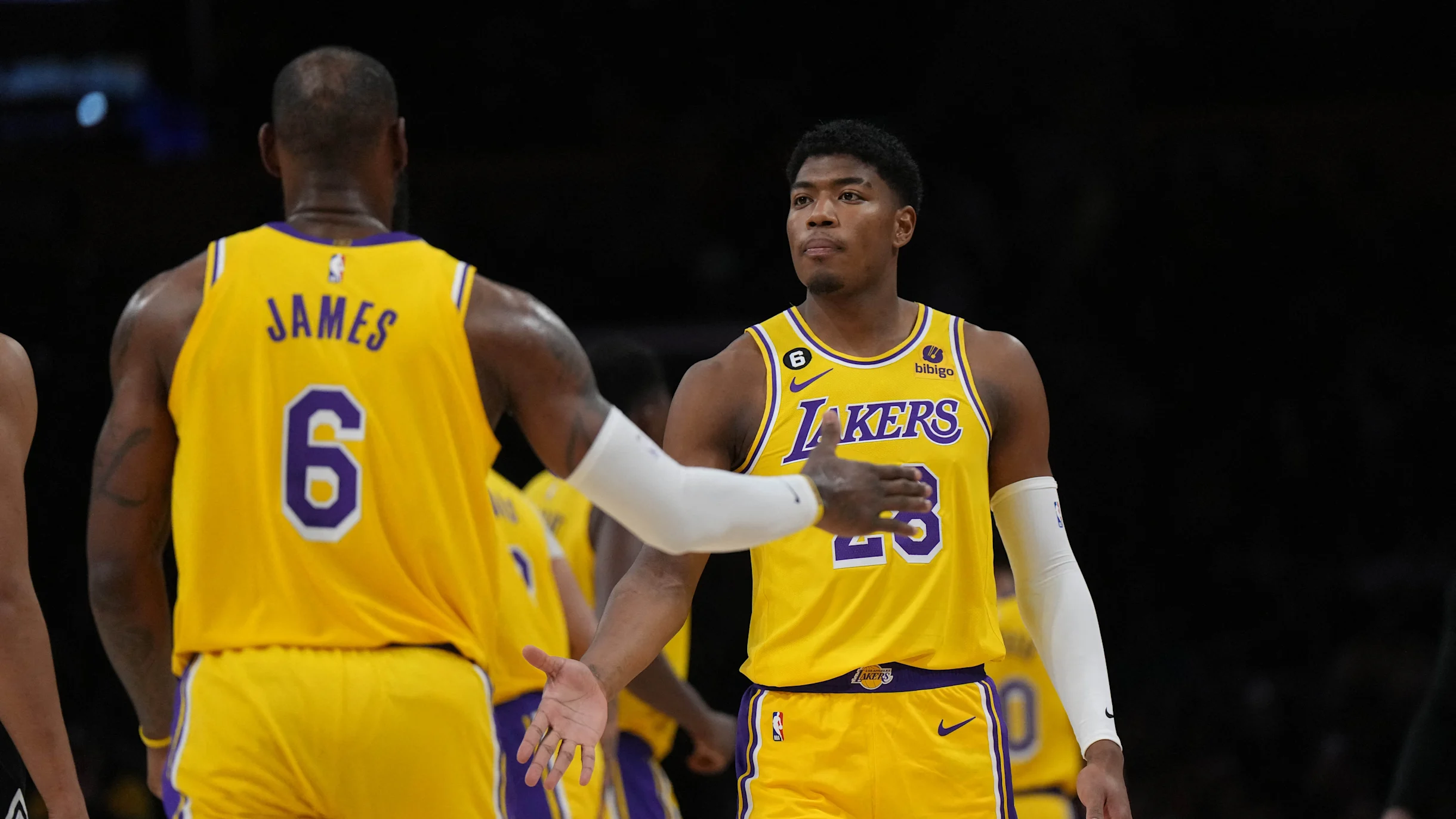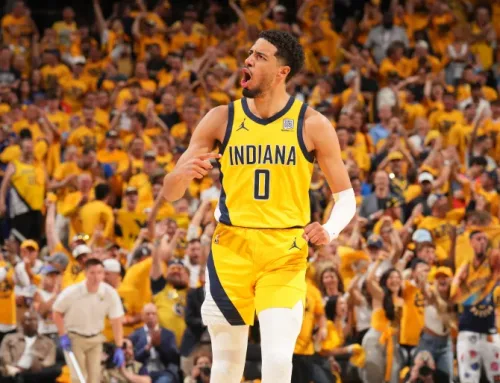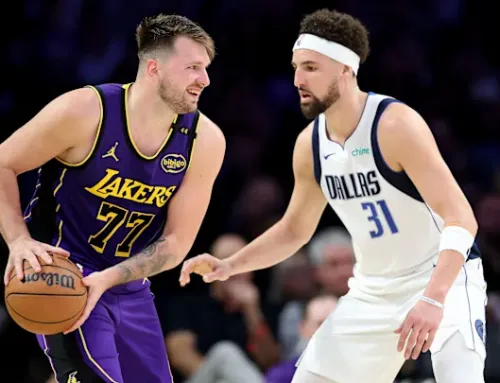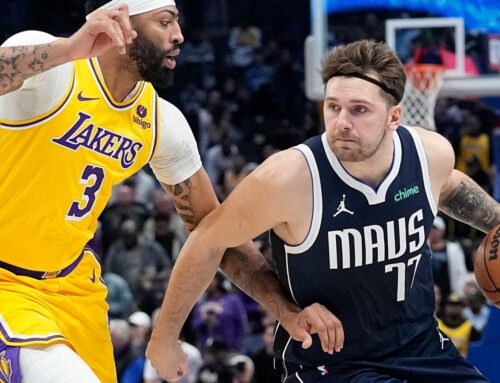By Avi Tyagi
This is an excellent case study on rejiggering a roster at the trade deadline. Here was the Lakers’ depth chart before the Rui Hachimura trade:
Primary rotation: (Must average > 18 minutes per game to qualify)
| Point | Dennis Schröder | Russell Westbrook |
| Combo | Patrick Beverley | Austin Reaves |
| Wing | Lonnie Walker IV | Troy Brown Jr. |
| Forward | LeBron James | |
| Big | Anthony Davis | Thomas Bryant |
Any lineup combination featuring any three of Schröder, Westbrook, Brown, Beverley, or Walker was defensively deficient, yet with minimal 3-point shooting or efficient shot creation to minimize the impact of those shortcomings. In 195 minutes with Schröder, Beverley, and Walker sharing the court, the Lakers were outscored by 12 points per 100 possessions. Despite often being surrounded by at least one of Davis or LeBron, the lack of scoring punch and defensive versatility from that particular configuration often counteracted the Lakers’ stars strengths. LeBron and AD PNRs had to operate in crowded paints with clogged driving lanes and AD had to cover too many reads at once with low-man responsibilities. Beverley was often overtasked as a wing defender, Schröder lacked the spacing he needs to maximize his drive-and-kick game, and Lonnie Walker was offensively overextended with the responsibilities of third scorer while facing larger wing defenders. With this new roster, that’s no longer the case.
Here’s their new team:
| Point | D’Angelo Russell | Dennis Schröder |
| Combo | Austin Reaves | |
| Forward/Wing | Rui Hachimura | Malik Beasley |
| Power Forward | LeBron James | Jarred Vanderbilt |
| Big | Anthony Davis | Mo Bamba |
Despite these new additions, L.A.L. has not lost its ability to pivot in the offseason. Only Jarred Vanderbilt’s 4.7 million was added as guaranteed future salary. In terms of tangible cap space, they only lost 2.1 million in likely cap space (due to the likelihood that since-traded Damian Jones would have picked up his 2.6-million-dollar player option for next season). The Lake Show would be able to walk into free agency with over 32 million in cap space, only committed to AD, LeBron, Vanderbilt, and rookie Max Christie. While it might be difficult in reality to find better alternatives in the competitive free agency landscape, the team has the option to swivel if certain new additions don’t mesh with their stars. At the draft, they would be able to trade the lesser first round pick between the Pelicans and Lakers and the 2029 Lakers’ first rounder if they so desired. Perhaps most importantly, the team has found a fair balance between preserving future mobility and remaking the current roster. For the cost of the 2027 Lakers 1st round pick (top 4 protected) and essentially 2 second round picks, these are tangible improvements up and down the depth chart that could vault the Lakers up the standings right now.
The addition of D’Angelo Russell would normally inspire some level of skepticism. A streaky point guard who has developed into a long-range launcher and score-first option, D-Lo’s biggest foibles exist on defense. With the Timberwolves, he was best served hiding in an orchestrator role, far from the action but able to use his vision to direct traffic ahead of him. Lebron has currently already occupied that role to preserve energy and to offer more defensive playmaking than Russell would. As such, D-Lo and LeBron would seem to be a clunky fit. Luckily, the surrounding pieces can help harmonize the units and allow each of the two to take the quarterback role in staggered lineups. Austin Reaves can step into a starting role to complement LeBron as a play finisher, willing 3-point shooter, and able defender. Jarred Vanderbilt is a brilliant point of attack defender and rangy, instinctive zone defender who can capably take isolation matchups against some of the best wings in the league (that might be helpful with KD out west now). When D-Lo goes to the bench, LeBron can call upon Malik Beasley’s 3-point pedigree for off-screen, on-the-move perimeter marksmanship. The LeBron-AD PNR will have room to operate in configurations featuring Reaves, Beasley, and Hachimura. As long as only one of D-Lo, Beasley, and Schröder are on the floor at any given occasion, the perimeter defense will likely be passable enough to allow the rim protection prowess of the backline defenders to shine. On that front, Mo Bamba has sneakily been a good defender. What he may lack in offensive polish and mobility or versatility as a defender, he makes up for with acceptable perimeter spacing (a 36% career 3-pt shooter on 6.8 attempts per 100 possessions) and excellent shot blocking. Thomas Bryant is a wonderful offensive center, but not yet an NBA level defender. His minutes as a backup were likely to be diminished in the playoffs and it was not feasible to build lineups with Bryant and Davis both on the floor. On the other hand, Bamba and Davis actually do complement each other well in some aspects. Davis could function as the center on offense while Bamba spaces from the wings, while Bamba could be the drop defender in certain schemes, with Davis as the roamer and likely one of Austin Reaves or even Vanderbilt navigating through screens on the pick and roll. A LeBron-Bamba-Reaves-AD-Beasley lineup might actually be a compelling combination. Reaves would chase primaries over the top of screens with LeBron communicating at the wings, Bamba back in a drop, and Davis able to stunt and close out to the perimeter if needed. On offense, it’s a different iteration of the classic LeBron-AD PNR with a spaced floor around them. It’s a niche grouping likely best saved for 2nd quarter bench matchups, but it’s a testament to the success of the retooling process that this version of the roster actually features so many suitable permutations.
With so many ex-Timberwolves, exploring the lineups employed by last season’s 7 seed offers some clues towards successful combinations this season. Russell-Beasley-Vanderbilt lineups were uber-successful last season, often fused with either Ant-KAT or Beverley-Towns. The Lakers can replicate those lineups with a variety of different configurations. Reaves-LeBron or Hachimura-LeBron could amalgamate with the aforementioned trio to similar effect, only without the glaring weaknesses of KAT’s lateral agility. With this new 9-man rotation, the Lakers’ have unbolted sundry lineups that were not previously possible. This might not be the best roster since their championship season, but it is very much their deepest. The Kuzma-KCP-Caruso 2021 roster lent itself to excellent defense, but the offensive creation and spacing were spotty at best and the bench options provided less flexibility in a playoff setting. For these Lakers to be successful and climb their way into the playoffs as a dangerous 7 or 8 seed, the coaching staff must balance tinkering with the desperation for wins. While it does make sense for unproductive lineups to quickly be phased out from their substitution structure, avoiding tinkering entirely would severely compromise the team’s potential. The 2021-22 Timberwolves succeeded due to the willingness of the coaching staff to fit lineups to the skills of the personnel, not to their positional designations. That determined approach to cast aside role rigidity was a key component to discovering the quarterbacking role for D’Angelo Russell, the hedging scheme designed to protect Karl Anthony-Towns, and the roaming role that built Jarred Vanderbilt as the focal point of the defense. It’s hard to say whether the Lakers’ lineup framers will ideate with the same vigor, but if they are willing, the Lakers may have just rebuilt their roster into a credible playoff threat. With the Jazz and Trail Blazers trading away starters for picks, the Lakers need only catch the Thunder or, dare I say, the Warriors to reach the 10 seed. It will likely take 42 wins to secure the 10 seed. At 26-31, that would require the Lakers to finish 16-9. The next 8 matches (against the Blazers, Pelicans, Warriors, Mavs, Grizz, Thunder, T-Wolves, and Warriors again) will likely determine their season. With a foundation built upon players who are all on the same page, the Purple and Gold might just cause chaos in a wild, unpredictable West.
